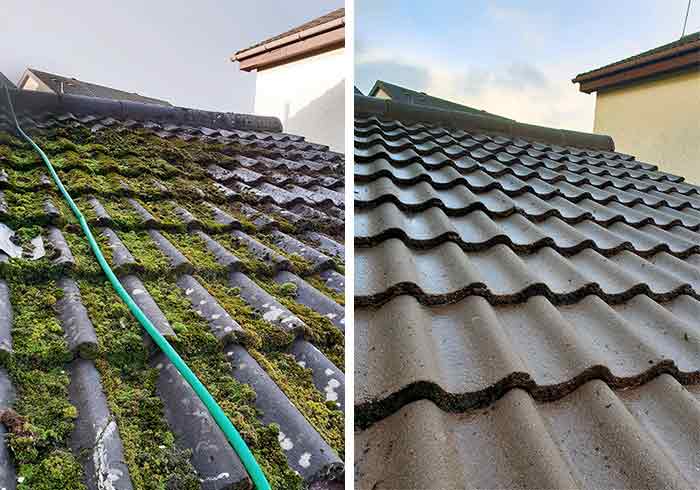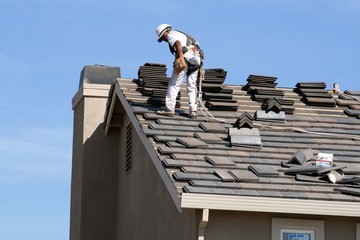It probably doesn’t take a genius to figure out that roof repair is better done at a time when the weather is calm. Nobody wants to be up on a ladder battling with the elements, especially when it’s raining or blowing.
Even a single missing shingle can result in major leakage and damage inside the house. This is why it’s imperative to do your best to prevent problems with regular maintenance.
A broken shingle isn’t just ugly; it can also lead to roof leaks. Luckily, fixing it is relatively simple if you can find a matching replacement. Before you start, however, it’s important to make sure your ladder is secure and that there’s someone at the base of the ladder to help if needed. It’s also a good idea to pick a day that isn’t too hot or cold; shingles are more likely to crack or break in extreme weather.
The first step is to remove the damaged shingle. You may be able to simply pull it up, but most of the time you’ll have to cut it free from the shingle below and above it. Use a flat pry bar or utility knife to shear the sealant bond between the shingle and its adjacent neighbors. This can be a tricky procedure; you’ll need to be careful not to tear the shingle below or the one above it. Once the glue seal has been broken, slide the pry bar under the edge of the shingle and gently lift it to free it from its nails.
Before you replace the damaged shingle, check to see if you have any spares. If not, you can purchase shingles from a home center or lumberyard. It’s important to choose a product that is the same size as the one you’re replacing; cutting a new shingle to fit can cause other shingles to buckle or pop their nails.
Roofing shingles come in a variety of colors and styles to match almost any aesthetic or architectural design. They are also low-maintenance and long-lasting, making them a cost-effective option for homeowners who aren’t interested in the expense of a full re-roof.
If a large number of shingles are damaged or if they’re near the eaves or other vulnerable areas of the roof, however, it might be more cost-effective to simply replace them all. Many homeowners’ insurance policies cover the cost of a whole-roof replacement if it’s necessary for safety or water protection. Depending on the cause of the damage, it’s a good idea to contact your insurer to make sure.
Flashing
Flashing is a thin sheet of metal that’s used to prevent water leaks. It’s installed in places where roof materials intersect, such as at roof valleys or around chimneys, vent pipes, and skylights. Flashing is usually made of a durable material like copper, aluminum, or galvanized steel, and it can be either exposed or concealed.
A roofer will use different types of flashing, depending on the job. For example, base flashing consists of two sheets of metal that can move over each other as the roof expands and contracts. It’s often used around chimneys and dormers. Other types of flashing include step flashing, which is used at the corner of a wall or shingle roof, and lead flashing, which is commonly used to protect drainage pipes.
Leaking roofs often have damaged or missing flashing. If the flashing isn’t replaced in time, it can allow water to seep under the shingles and into a home or business. It’s important to check the flashing regularly and repair it as soon as possible to avoid major problems.
The signs of a flashing problem are often easy to spot. For instance, you may notice lifted shingles in the area of the damaged flashing. Other signs of flash damage include exposed edges and cracks. If you notice these signs, call a roofing professional to have the flashing repaired.
When repairing roof flashing, it’s important to remove the damaged piece and then apply new sealant. It’s also a good idea to replace any cracked or missing shingles.
Ideally, flashing should be sealed with a silicone or rubber sealant that’s resistant to weathering and corrosion. It’s best to use a waterproof sealant that’s designed for roof flashing.
If you’re concerned about the condition of your roof’s flashing, contact a professional roofing company in Pasadena. They’ll be able to provide an inspection and an estimate for repair or replacement. They can even help you choose the right type of flashing for your home or business. Having the flashing properly repaired will help to prevent leaks and prolong the life of your roof.
Vents
Vents, including power and gable end vents, pull hot air from attics to help maintain an even temperature for the rest of your house. However, if not properly operated (or closed), these can promote attic condensation that will shorten your roof’s lifespan and contribute to leaks.
To check for problems, get up in your attic or crawlspace and examine the interior of your vents. Look for damp stains or drips. Also inspect your plumbing vent boots, which slide down around pipes protruding through the roof. These are usually rubber, but you can replace them with metal vents if the housing cracks or if there are broken seams or pulled nails.
Gutters
Gutters are the freeway system for rainwater, directing it from where it falls, on your roof, to where it needs to go—away from your house. They’re essential to prevent water damage to the siding, foundation, and basement of your home, as well as to reduce erosion and prevent rot in the fascia boards and soffits. They’re also useful in preventing leaky roofs.
A gutter consists of the trough that collects and carries rainwater, plus the downspouts that direct it away from your house. The trough is usually lined and has been made from a variety of materials, including wood, lead, galvanized metal, and UPVC or PVCu. Gutters can be installed with or without the soffit and fascia, depending on the structure of the house and your preferences.
Clogged or damaged gutters can cause expensive structural damage to your home, so it’s important to maintain them properly. You should clean your gutters regularly to remove any leaves, twigs, or debris that builds up and can clog the system. You can do this yourself or hire a professional roofer.
Besides cleaning your gutters regularly, you should also inspect them for signs of a leak or holes. If you spot any problems, they can be easily repaired or patched up before they become serious, saving you money in the long run.
If your gutters are leaking, it may be because of a hole in the seam or a loose fitting. You can fix this by replacing the end caps, splices, or drop outlets and sealing the new section to the existing gutter with sealant formulated for gutters. It is available at most hardware stores. Screened gutter guards, which you can buy at home centers, don’t work as well—they allow smaller debris, like pine needles and seeds, to pass through. They also make the job of cleaning gutters more difficult.



